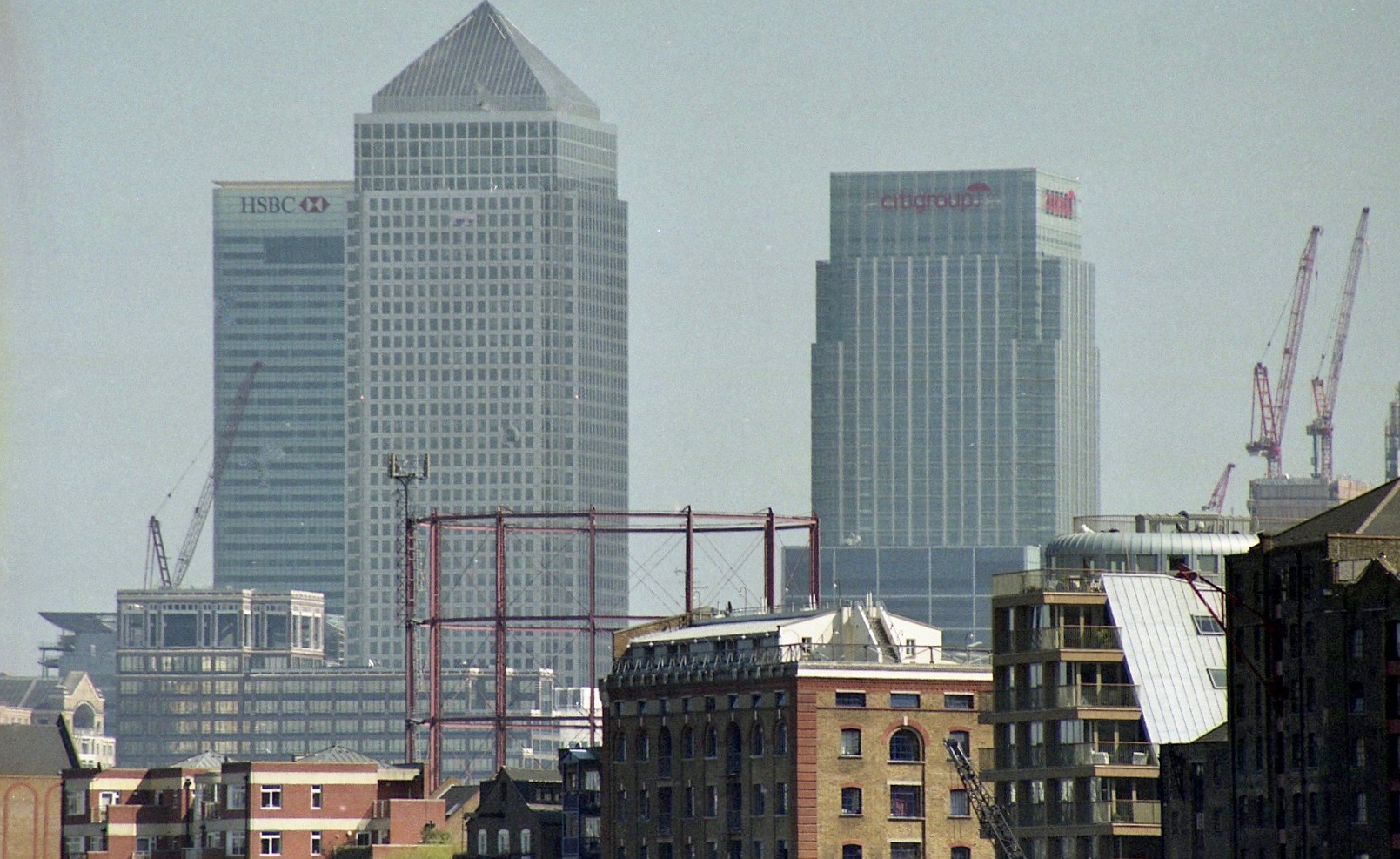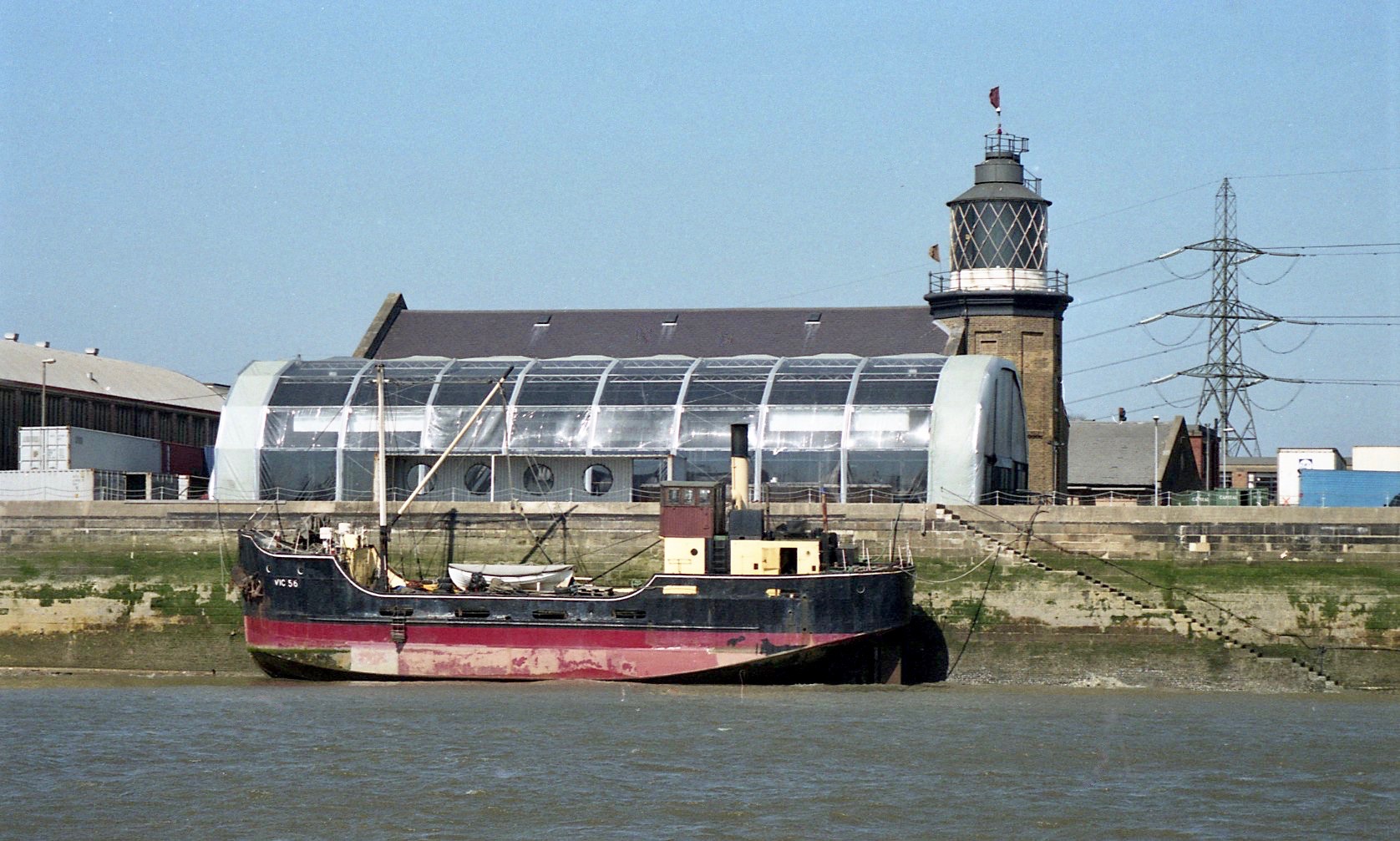CLICK ON ANY IMAGE IN EACH GROUP TO ACCESS ENLARGED GALLERIES
Today I scanned another batch of colour negatives from Norman’s 70th birthday party, the first part of which I featured yesterday.
Norman’s guests soon filled their plates with items from the splendid buffet on the lower deck.
They then wrapped themselves up in order to enjoy convivial company in the crisp, bright, open air on the upper level.
Norman engaged in his usual animated conversation.

As we passed Canary Wharf which dwarfs the older buildings standing nearer the river, I reflected that, whilst running my London marathons in the early 1980s, I, and others had tracked their flattened site when One Canada Square and its neighbours were still on the drawing board. Less than two decades ago we were speculating about what would be filling the spaceGoogle has this information, among other entries: ‘Canary Wharf is a busy financial area filled with skyscrapers like the glittering One Canada Square. Canada Square Park hosts summer concerts and a winter ice-skating rink, while the Museum of London Docklands draws families with model ships and hands-on displays. Casual cafes bustle during the day and, come evening, post-work crowds gather in stylish wine bars and pubs. Ferries called Thames Clippers ply the river.’
I wonder whether the red framed gas holder in this shot is still extant.
A stir of spectators, raising of binoculars, and expressions of wonder

as we passed Trinity House, heralded our approach to

The Thames Barrier.
The website of Trinity House offers the following information:
‘Trinity House is a charity dedicated to safeguarding shipping and seafarers, providing education, support and welfare to the seafaring community with a statutory duty as a General Lighthouse Authority to deliver a reliable, efficient and cost-effective aids to navigation service for the benefit and safety of all mariners.
The Corporation of Trinity House was incorporated by Royal Charter in 1514 to regulate pilotage on the River Thames and provide for aged mariners.
With a mandate that has expanded considerably since then, we are today the UK’s largest-endowed maritime charity, the General Lighthouse Authority (GLA) for England, Wales, the Channel Islands and Gibraltar and a fraternity of men and women selected from across the nation’s maritime sector.
Our long-standing familiarity with the channels, hazards, currents and markings of our coastline also qualify us to inspect and audit almost 11,000 local aids to navigation, license Deep Sea Pilots and provide Elder Brethren as Nautical Assessors to the Admiralty Court.
Per annum the charity donates around £4m to the charities we support. These include the provision of cadet training schemes, welfare provision for retired mariners and educational programmes teaching safety at sea skills.
Our mission
Our mission as a General Lighthouse Authority is to deliver a reliable, efficient and cost-effective aids to navigation service for the benefit and safety of all mariners.
Furthermore, as a charity we help to ensure that British commercial shipping is crewed by well-trained men and women and that mariners in need of all ages and backgrounds are supported in a number of ways either directly by us or through grants to other maritime charities and initiatives.
Trinity House works closely with a number of highly-regarded national and international organisations, including the Northern Lighthouse Board, the Commissioners of Irish Lights, the Maritime & Coastguard Agency, the UK Hydrographic Office and the International Association of Marine Aids to Navigation and Lighthouse Authorities (IALA) , to name just a few.
Our vision
Our vision is to be a trusted world class organisation and regarded as such by our stakeholders.
We work hard to ensure that we are valued as much for our work today as for our reputation earned through over five centuries of service.
Although we are proud of the reputation afforded us by our many centuries of dedication to the nation’s maritime infrastructure, we are a forward-facing organisation; it is our ability to meet new challenges and the changing requirements of the modern mariner that keeps us relevant and effective.
We will continue to support the maritime industry that moves up to 95% of the UK’s international trade, keeping the lifeblood of our economy moving safely and swiftly and ensuring the UK’s place in the 21st century global economy.
Marine operations
At the business end of Trinity House we operate a fleet of vessels, working in our waters at the highest levels of seamanship.
We have been operating in the waters around England, Wales and the Channel Islands since 1741, using purpose-built tonnage equipped to the highest technical standard and manned by professionally qualified officers and crew.
Coordinated and monitored around the clock by our Planning Centre, typical vessel activities include wreck location and marking, aid to navigation maintenance, towing, buoy handling and surveying.
Working at sea is unpredictable and inherently hazardous; to preserve the safety of the mariner we take measures to make sure we can respond effectively should an incident occur, working closely with our partners at the Department for Transport and the MCA. We have a vessel ready to respond within six hours of the Strait of Dover, carrying our instantly recognisable Emergency Wreck Marking Buoys.’
Concerning the Thames Barrier’s flood defences, extracts from a Guardian article of 19th February 2015 show that ‘The Environment Agency’s “at risk” list includes the Houses of Parliament, Whitehall, City Hall, Canary Wharf, Westminster Abbey, the Tower of London, Kew Gardens, the O2 Arena, 51 railway stations, 35 Underground stations, eight power stations, more than 1,000 electricity substations, 400 schools, 16 hospitals and over half a million of Greater London’s roughly 3.3 million homes – not to mention 1.5 million of its people. Large areas of Southwark, Lambeth, Tower Hamlets, Hammersmith, Fulham, Wandsworth, Barking, Dagenham, Woolwich and Newham could find themselves under water, along with many settlements along the estuary in Essex and Kent.’ Also that during the period from ‘early December 2013 to the end of February [2014], its steel gates were closed a record-shattering 50 times, preventing the river from running riot. Previously, the barrier had closed only 124 times since it began operating in 1982. The agency described this sharp increase in demand as a “blip” and, apart from routine testing, the barrier hasn’t been closed since. However, during its lifetime there’s been a strong, overall upward trend: it was closed four times in the 1980s, 35 times in the 90s, and 75 times in the 2000s. There have been 65 closures since 2010, suggesting this climb is continuing.’
[youtube https://www.youtube.com/watch?v=Dvg2asACsG0&w=560&h=315]
[This 6 minute video graphically describes how the structure works.
This celebration will require possibly one more instalment.
Jackie produced succulent chicken in a Nando’s lemon marinade on a bed of peppers and onions, accompanied by new potatoes and green beans. She drank sparkling water and I finished the Pyrene.

A very enjoyable tour – as always. Thanks, Derrick.
Many thanks, Roland
Fascinating Derrick, thoroughly enjoyed the descriptive video of how the Thames Flood Barrier works.
Many thanks, Ivor. Right up your street, perhaps
Great video
Many thanks, Oglach
I enjoyed part 2, too. 🙂
🙂 Thanks very much, Merril
So many smiling faces…I love that!
Many thanks, Jill
I did not know about the Thames Flood Barrier – what a genius piece of engineering and the figures on its use are most interesting too!
Many thanks, Pauline
What a great way to celebrate a birthday! Jackie sure can cook!
Many thanks, Laurie. For the last couple of days she has also cooked and frozen lamb jalfrezi and beef in red wine for 18 for Boxing Day.
Wowsah! I am so impressed. I made two pans of baked penne for 7and thought I was doing well. 😉
🙂
Thames Barrier – The next few decades are going to be … interesting. 🙂
They sure are, Widders. Many thanks
Another splendid post and photos, Derrick! 🙂 <3 xoxo
Many thanks, Natalie
That is great people photography. I enjoyed the working of the London Flood Barrier. From now on, I will always remember it every time I think of London.
Very many thanks, Uma
Lovely photos Derrick, a splendid tour of the place.
Thanks very much, Arlene
Another amazingly informative post, in addition to showing us the ongoing birthday celebrations. The info about Trinity House was interesting. I’ve never looked deeply into what its actual function and aims were before. But the video about the Thames Barrier was excellent. I’ve seen snippets of it in action before, but this video was very thorough. The Thames Barrier is certainly an awesome piece of engineering. Thank you for sharing, Derrick.
I forgot to wish you and your family a really happy Christmas and a wonderful new year. 😀
Many thanks, Millie. It is reciprocated
Wow! Informative and well written. You ought to have your own tv show ?
Many thanks, Rose
Derrick, for some reason I wasn’t able to post my lengthy comment on my cellphone today. I had to close all my windows and start over. I have been finding my phone doing this on blogs with more than four or five photos. Hopefully, it will become better again once I go home after the holidays!
I enjoyed the festive partygoers, Trinity House charity details and the Thames floodgate notes. Many happy wishes for you, Jackie and family for the merriest of Christmases and a Happy New Year ahead.
PS. Randy seemed nearly himself yesterday. We took Mom (30 years Spanish teacher) to the children’s animated Hispanic film, “Coco.” It brought all but my Mom to tears. The bridge from the death and life on La Dia de los Muertos was gorgeous in it’s depth and animation. Not so much for children but Randy truly loved the artwork. He’s been selling his simpler prints, magnets and less expensive art and hopefully, since he started a new canvas, he will go back to working on his projects. Thanks for your concern and caring. Xo
Very many thanks for taking so much trouble, Robin. I hope you will all enjoy Christmas X
The flood gates is impressive! Loved all the photos, especially Norman’s animated conversation. 🙂
Many thanks, Lavinia
See my hometowns get a mention, Lived in Becontree in the Borough of Barking postal address Dagenham
I’m pleased to have mentioned them, Brian. Many thanks
Lots of interesting information there. Thanks.:-)
Glad you liked it, Quercus. Thanks a lot
🙂